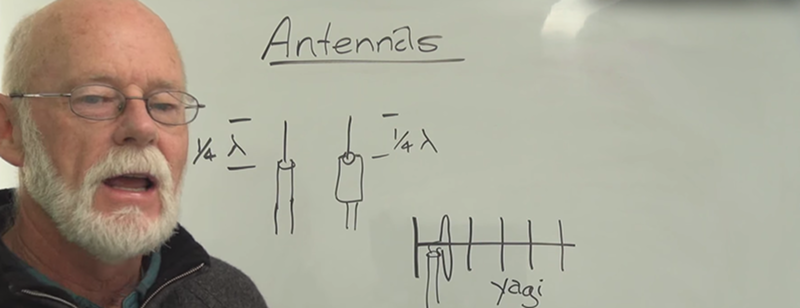Like a lot of people, [Bruce] likes radio controlled (RC) vehicles. In fact, many people get started in electronics motivated by their interest in RC. Maybe that’s why [Bruce] did a video about antenna basics where he spends a little more than a half hour discussing antennas. You can see the video below.
[Bruce] avoids any complex math and focuses more on intuition about antennas, which we like. Why does it matter that antennas are cut to a certain length? [Bruce] explains it using a swing and a grandfather clock as an analogy. Why do some antennas have gain? Why is polarization important? [Bruce] covers all of this and more. There’s even a simple experiment you can do with a meter and a magnet that he demonstrates.
If you know what a Smith chart is, this probably isn’t the video for you. If you don’t, this video isn’t going to cover anything like that. But if you want a better foundation about what antennas do and why they work, this is a good spend of 30 minutes.
If you want more info on the Yagi that [Bruce] mentions, we’ve talked about them before. We’ve also covered a similar intuitive antenna tutorial that uses a lot of interesting animations.
















With respect with the dude’s effort, I feel the student would be better of searching for military training videos on the topic. Age is relative, only but I doubt the man is old enough to be around when the ether or aether was falsely believe to exist. No problem in using the therm in jest, but it has no place in wireless RF transmission instruction. A resonant antenna can act similar to a tank circuit, but a receive antenna designed to be resonant on longer wavelengths will work with the shorter wavelengths without loss. Radio hobbyists hope to construct the longest possible antenna for use for all receivers The radiation patterns of various antennas where worked out long ago without anechoic chambers. In our modern world filled with numerous signals and reflective surfaces the chambers have become necessity in designing antennas for use in the modern world, but a simple antenna range still works for most hobbyist with the room to put one in place.
If you don’t mind giving up selectivity at the antenna stage, then the log-periodic antenna would be the choice for ultra-wide band usage.
> Age is relative, only but I doubt the man is old enough to be around when the ether or aether was falsely believe to exist.
The problem is “when the ether was falsely believed to exist” is in itself an ill-defined point in time. But if we take the Michelson-Morley experiment [1] (50-50 hindsight and that) as the turning point then yes, that’s 130 years ago.
[1] https://en.wikipedia.org/wiki/Michelson%E2%80%93Morley_experiment
Oh please! I knew a broadcast radio engineer who was probably a similar age if not a little younger and had a military background that mentioned the ‘aether’ when talking about radio in a manner similar to this guy all the time! It wasn’t that he believed in it in the sense that early radio experimenters did. It’s just a sort of poetic description.
Besides… go read a book or watch a video about nothingness by Lawrence Krauss and come back and tell us that physicist’s current best model of the universe doesn’t still “sort of” include the aether!
http://www.sciencemag.org/news/2017/08/mini-antennas-could-power-brain-computer-interfaces-medical-devices
Antennas are still evolving.
That’s a very cool paper. I’m goinig to have to write that one up! Thanks!
> most of you … have better things to do than watch me talk at a white board
you must be new here
I haven’t had opportunity to watch this video yet, but this one is pretty amazing too. I learned a lot from it:
Everything you always wanted to know About Antennas (but were afraid to ask) || Frank Rutter K3AW
https://www.youtube.com/watch?v=LEigIMS6bo4
That was like watching Walter White dubbed with Australian accent. Vibrating magnets over the DMM, that was amazing to me, so I repeated the experiment using with a uCurrent Gold. It was worth watching just for that alone. I found this very informative because as an EE noob I struggle to understand some of the terminology surrounding antennas. All gris to the mill.
Two antennas on a roof decide to get married. The wedding was fine, but the reception was awesome!
There is no such thing as a MONOPOLE-antenna. Period.
Antenna companies sell monopole antennas, but when mounted to a ground plane they combine with their reflection to form a virtual dipole with altered propagation characteristics.
https://www.pulseelectronics.com/news-619-253-pulse_monopole_antennas_enable_multiple_m2m_applications/
Absolutely love it. Easy to follow, know more about antennas now ! That’s what it is about, right! Great job
He has humor, good speed, fine examples. Great teacher.
The job is “when the ether was falsely believed to live” is in itself an unclear full stop in sentence. If you get into’t intellect giving up selectivity at the antenna level, then the log-periodic antenna would be the choice for ultra-wide banding custom.
I’m not an antenna expert by any means. But the very start of this video kind of put me off… his explanation with the moving magnet, while intuitive, mixes together the concepts of reactive electromagnetic fields (near field) and radiating electromagnetic fields (far field), which are different concepts. I much prefer this article: http://m.eet.com/media/1141963/21352-82250.pdf . That article clearly distinguishes between the near (reactive) field and the far (radiated) field.